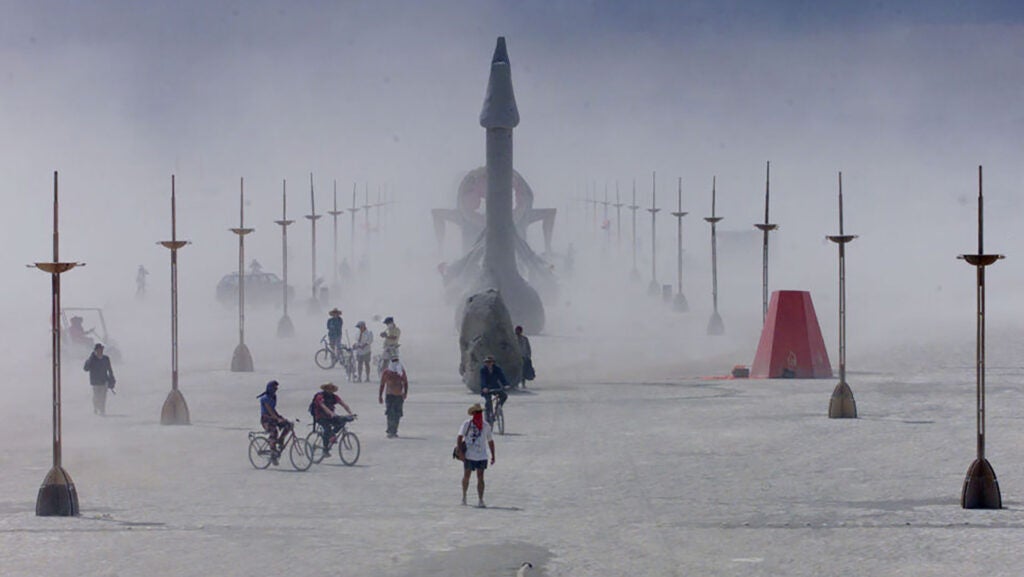A broken back and ribs, a bruised spleen, and a punctured lung—Rachael Gingery’s list of injuries looked like the aftermath of a WWE wrestling match, not a trip to an art and culture festival inspired by such lofty ideals, self-described as “community, art, self-expression, and self-reliance.” But that’s what Gingery told SFGATE she endured in 2024 during her eighth Burning Man festival.
On August 24, SFGATE published an in-depth look at injuries that people have sustained at Burning Man. And how these calamities often lead to massive medical bills.
The injuries—which Gingery sustained after falling 20 feet off the top of an art installation, landing squarely on her back—saw her spend more than 16 hours in a medical tent. Despite a lengthy recovery, she returned to the event again this year without hesitation.
“I appreciate that Burning Man is a little bit dangerous,” she told SFGATE. “It’s kind of what makes it exciting.”
Gingery’s case isn’t an anomaly. She was one of more than 1,500 people injured at the festival last year. Even more injuries were reported in 2022 (5,376) and again in 2023 (3,347) when the dry lakebed, “the playa” hosting the festival, flooded amid a torrential downpour, prompting a stranded Outside contributor to defecate into a plastic bag (due to problems with the bathrooms).
This year’s festival, which began on Aug. 24, has already dealt with hazards. The day before kickoff, the playa was hit by a severe dust storm. Winds reached speeds of 52 miles per hour, flipping over tents and art installations, according to SFGATE.
“It got us good. It got the city real good,” one attendee reported on Facebook. “There are a couple of camps that got completely thrashed.”
Conditions have since improved, but at least four people were reportedly injured in the storm, and weather forecasts are now warning of heavy rain through part of the festival.
Burning Man champions self-reliance, and attendees are responsible for sourcing their own food, water, and shelter while on the playa. Multiple medical clinics are also scattered throughout the grounds to take care of injured or ill “burners.” And while some medical ailments, such as dehydration, sunburn, and heat stroke, are part and parcel to a nine-day outdoor festival taking place in the Nevada desert in late August, many Burning Man injuries are far more outlandish.
A woman was hit by an “art car”—a parade float-like vehicle—and killed at the event in 2014. Another was killed in a similar accident in 2003. In 2017, a sleeping man was critically injured when a festival employee drove a truck through his tent. That same year, a man hurled himself into the festival’s eponymous burning effigy and later died from his injuries.
“We don’t know if it was intentional on his part or if it was just kind of induced by drugs,” a local sheriff told CBS News. The following year, another man was seriously injured after falling off a stack of cars between 50 and 60 feet tall.
Festivalgoers are required to sign liability waivers to enter the festival, acknowledging responsibility for possible injury and death. But for some, the real damage doesn’t come to the body, but to the wallet.
One GoFundMe from 2024 looked to recoup losses from a $25,000 ambulance ride. Another sought $3,600 to support a woman airlifted out of the festival after suffering second-degree burns during “a freak accident involving a flaming drink at a bar.” A third looked for $100,000 in funds to aid a woman who was “catapulted from a swing” and ended up with a fractured skull and vertebrae, a broken pelvis and ribs, a lacerated liver, and a punctured lung.
Gingery had no qualms about returning to the event after her fall in 2024, noting the event’s “no guardrails” nature is part of the appeal.
“If you choose to engage in dangerous behavior out there, there are real consequences for those choices, and those consequences fall squarely on your own shoulders,” Gingery said.


